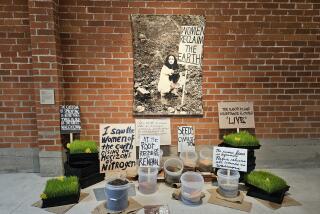Beauty and the Bust : ‘Wandering’ Takes Fanciful Tack; ‘Home Invasion’ Clunks Along
- Share via
IRVINE — Art installations created for specific sites have become enormously popular in recent years, but artists too often fail to invest them with fresh approaches that are fully thought through without being narrowly dogmatic.
Cornelius O’Leary’s new site-specific piece--”Wandering Home,” at the Irvine Fine Arts Center--is a happy exception. It incorporates a subtle meditation on ritual, human psychology and landscape, and even invites the viewer to glimpse the workings of the artist’s creative process. O’Leary’s approach is so buoyantly inventive that hordes of small children walking past it, en route to summer crafts classes, pause to investigate.
The piece consists of nine fancifully constructed turtle shell forms, arranged on the floor as if they were slowly making their way toward the lake behind the center, visible through the windowed rear wall.
One “shell” is a stout piece of wood carved into a steep hump that sprouts tall, gracefully droopy driftwood “leaves.” Other shell forms were made from such materials as cigarette butts stuck into sand, a tightly packed arrangement of rolled-up red socks, and a wire-spoke wheel garnished with dried palm tree husks.
In a viscerally goofy image of impending danger, an oozing piece of “snot” (actually a stocking with rock crystals in its toe that stretches tautly from the ceiling) looks about to plop onto a shell pieced together from scraps of ornamental metal.
More turtle shapes appear in an array of small sketches by O’Leary, on which he has jotted thoughts on diverse topics (including himself: “not so comfortable with people as with nature and things”).
There are also several copiously underlined books owned by O’Leary. The titles alone--”Spectacular Helmets of Japan”; “Alienation in Modern Society”--hint at some of the broadly anthropological themes of the piece.
O’Leary remarks in a note that the piece is based on a photograph he saw of Galapagos Island turtles looking like rocks in a stream; indeed, the animals’ slowness allows them to be seen as part of the landscape. Turtles’ protective shells also recall the shapes of helmets and shields, the historically often showy and talismanic accouterments of war.
Living indoors but slowly “migrating” outside to the lake, O’Leary’s mock turtles are hybrids of nature and culture, incorporating urban detritus with the organic “castoffs” of nature. As an artist, he is always collecting such objects; he writes that he “gathers things around me as a source of comfort.”
Thus does O’Leary subtly interweave various notions about humans--vulnerable but bellicose and vain; careless with the world’s bounty yet worried about their own survival; scavenging and hoarding to keep the bogeyman at bay.
*
“Home Invasion,” the amusingly overheated, sci-fi-ish title of a group of installations at the Marie Elias Center for the Arts in Santa Ana, sounds promising. But most of the pieces are hell-bent on conveying some heavy-handed and numbingly obvious message that is news to nobody, with visual means that are hopelessly clunky or derivative, or both.
The best of the lot, an installation by Inka Bujalski and Rachel J. Siegel, involves a welcome dose of ambiguity but suffers from conceptual weakness and presentational glitches.
In a series of “biographical” wall texts, the artists introduce Rinka Racha Inkel, purportedly a mysterious former Santa Ana resident, who traveled the world, gathering herbal specimens for her potions.
The center’s small front parlor contains arrangements of dried plants, a journal, old photographs, a flowered dress and an album of travel snapshots and botanical sketches. All were supposedly owned by Inkel, a handsome woman who wears a 1920s-era cloche hat in one photograph but looks suspiciously modern in another.
Her odd name obviously is an amalgam of the artists’, who further emphasize their handiwork by endowing her with the ability “to feel two or more conflicting emotions at once.” Further fakery abounds in the journals, written in the same style as the artists’ wall texts, and in the album, which contains what appear to be photocopied black-and-white photographs.
Absurdity rules in the artists’ description of a shelf of pastel bar soaps carved in a quasi-Mayan style as Inkel’s “carved female figures from all over the world.”
If more care and consistency had gone into the fabrication of the piece, it might have been more effectively open-ended, exploring the way history construes and misconstrues personalities and facts from the fragile, flawed data we leave behind.
* “Wandering Home,” through Sept. 11 at the Irvine Fine Arts Center, 14321 Yale Ave., Irvine. Hours: 9 a.m.-9 p.m. Monday-Thursday; 9 a.m.-5 p.m. Friday; 9 a.m.-3 p.m. Saturday; 1-5 p.m. Sunday. Free. (714) 724-6880.
* “Home Invasion,” through Aug. 24 at the Marie Elias Center for the Arts, 120 W. 20th St., Santa Ana (across from the Bowers Museum). Hours: 3-9 p.m. Friday, noon-6 p.m. Saturday and Sunday, and by appointment. Free. (714) 568-9901.
More to Read
The biggest entertainment stories
Get our big stories about Hollywood, film, television, music, arts, culture and more right in your inbox as soon as they publish.
You may occasionally receive promotional content from the Los Angeles Times.










